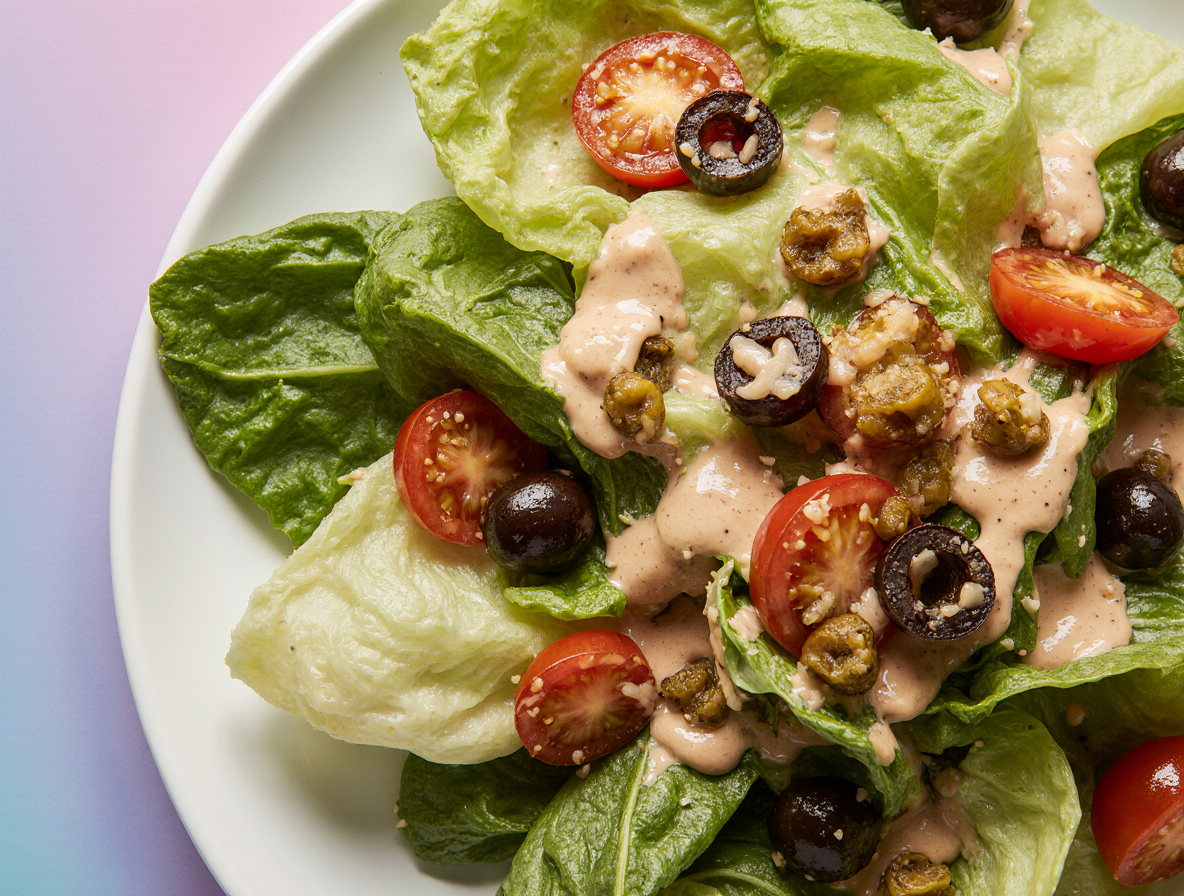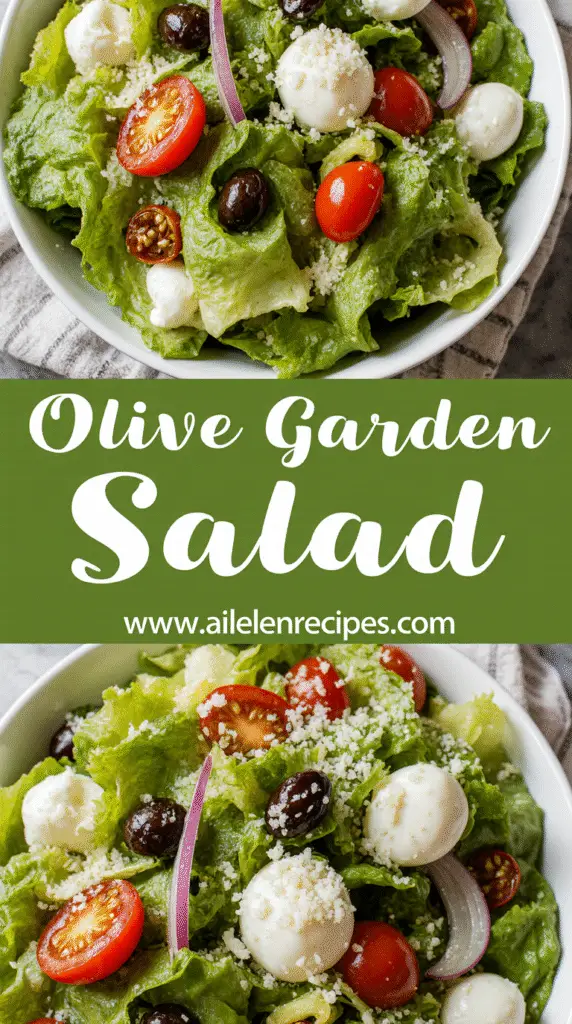How to Make Olive Garden Salad Recipe: A Restaurant-Quality Guide
Have you ever craved that iconic olive garden salad recipe that has developed a cult following for good reason? I certainly have! This crisp, fresh, and utterly addictive combination has become a staple in many homes, including my own.
Despite the seemingly odd combination of flavors, this classic favorite takes little effort to recreate. The olive garden italian salad recipe perfectly blends fresh lettuce with flavorful tomatoes, pepperoncini, and black olives – all topped with that signature zesty dressing. When examining the olive garden salad ingredients more closely, it’s surprisingly simple: pre-cut lettuce, onions, tomatoes, black olives, and pepperoncini with croutons. At just 156 calories per serving, what is in olive garden salad actually creates a surprisingly balanced dish that serves 8 people.
In this guide, we’ll walk through how to make olive garden salad that tastes just like the restaurant version. From selecting the freshest ingredients to mixing that perfect dressing, you’ll soon be enjoying endless bowls of this beloved salad without leaving your kitchen. Let’s get started!
What Makes Olive Garden Salad So Popular
The Olive Garden salad has achieved near-legendary status among restaurant dishes. Over the past 30 years, this simple yet satisfying combination has become the signature appetizer that keeps customers returning time after time.
The signature flavor profile
The magic of this iconic olive garden salad recipe lies in its perfect balance of textures and flavors. Unlike most restaurant side salads that merely offer a pile of lettuce with a few sliced vegetables, Olive Garden loads theirs with goodness in every bite. The combination might seem unusual at first glance—crisp lettuce, juicy tomatoes, salty black olives, tangy pepperoncini, nutty Parmesan cheese, and crunchy croutons—but together, they create a harmonious blend that’s both refreshing and satisfying.
Moreover, the contrast between crunchy and soft elements alongside salty, tangy, and slightly spicy notes creates a multidimensional experience. Each ingredient plays a crucial role in the overall flavor profile, with none overpowering the others.
Why the dressing stands out
The true star of the olive garden salad ingredients, however, is undoubtedly the signature dressing. This creamy Italian concoction has maintained its popularity with guests for almost three decades. Crafted from a special blend of Italian spices, oil, vinegar, and Romano cheese, the dressing delivers a distinctive tangy kick with just the right amount of sweetness.
What sets this dressing apart is its creamy texture, achieved through the addition of eggs and mayonnaise—a secret that gives it body without overwhelming the fresh ingredients. Furthermore, the dressing contains no high fructose corn syrup or artificial flavors, allowing the natural flavors to shine through.
The appeal of simplicity and freshness
Perhaps the most important component in Olive Garden’s salad success is the emphasis on freshness. An Olive Garden line cook confirmed that all salad toppings, including tomatoes, pepperoncini, and black olives, come to the restaurant fresh and are prepared in-house. Additionally, these ingredients undergo rigorous quality checks between lunch and dinner shifts.
The restaurant’s preparation technique also contributes significantly to the salad’s appeal. The dressing isn’t added until right before serving, preventing the salt content from making the lettuce wilt. This attention to detail ensures that customers always receive a crisp, vibrant salad that provides a complete sensory experience—from the cool, crisp lettuce to the juicy tomatoes and tangy dressing.
Ultimately, it’s this combination of quality ingredients, thoughtful preparation, and that irresistible dressing that has made the olive garden italian salad recipe a beloved favorite across America.
Gathering the Right Ingredients
Creating an authentic olive garden salad recipe begins with selecting the right ingredients. As I’ve discovered through trial and error, quality components make all the difference between an ordinary salad and that restaurant-quality experience we crave.
Lettuce and greens: iceberg vs romaine
The foundation of any olive garden salad ingredients list starts with fresh, crisp lettuce. While the restaurant traditionally uses a mix of iceberg lettuce with red cabbage, many home cooks find that combining iceberg with romaine creates the perfect balance of crunch and substance. Specifically, the iceberg provides that signature crispness, whereas romaine adds nutritional value and holds dressing better. For added dimension, some recipes incorporate matchstick carrots and purple cabbage into the mix.
Tomatoes, onions, olives, and pepperoncini
Roma tomatoes are ideal for this recipe due to their juicy, sweet flavor and firm texture that doesn’t make the salad soggy. Thinly sliced red onions provide a sharp contrast—keep them in rings for that authentic presentation. Black olives contribute a mild, briny flavor, while whole pepperoncini peppers add that distinctive tangy kick essential to the olive garden italian salad recipe. These jarred peppers can be found near pickles in most grocery stores.
Choosing the best croutons and cheese
Croutons provide necessary crunch—either store-bought or homemade will work, though making your own allows for customized seasoning. Simply cube bread, toss with olive oil and Italian herbs, then bake until crisp. For cheese, freshly grated Parmesan or Romano delivers the most authentic flavor. Many experts recommend shaving or grating from a block rather than using pre-packaged varieties.
Where to find Olive Garden salad dressing
You have two excellent options for the dressing. First, purchase the bottled Olive Garden signature Italian dressing available at many grocers including Walmart, Target (rated 4.7 out of 5 stars with 628 reviews), or Amazon. Alternatively, make your own olive garden salad dressing recipe using ingredients like olive oil, mayonnaise, vinegar, lemon juice, and Italian seasonings.
How to Make Olive Garden Salad at Home
Assembling your own olive garden salad recipe at home is remarkably straightforward. With all your ingredients gathered, let’s break down the process into simple steps that guarantee restaurant-quality results every time.
Step 1: Prep the vegetables
Initially, proper preparation makes all the difference. Begin by thoroughly washing and drying your lettuce—excess moisture will dilute your dressing. Use paper towels to absorb any extra moisture from sliced tomatoes to keep everything crisp. Next, slice Roma tomatoes into rings or halves if you prefer smaller pieces. For red onions, cut them into thin rings (a mandoline works perfectly) and then into bite-sized pieces if desired. Drain the black olives and pepperoncini peppers completely.
Step 2: Mix the salad base
In a large bowl, combine your garden salad mix or iceberg lettuce with the sliced tomatoes, red onion rings, black olives, and shredded carrots if using. This creates the foundation of your olive garden italian salad recipe. For larger gatherings, you can prepare this base up to 8 hours ahead—simply cover with plastic wrap and refrigerate until needed.
Step 3: Add dressing and toss
The secret to perfectly dressed salad lies in the technique. Instead of pouring dressing directly over the vegetables, add it to the side of the bowl first. This allows for more controlled distribution as you toss. Gently mix until ingredients are lightly coated—you’ll need approximately 2/3 cup of olive garden salad dressing recipe for a large salad, though having extra on hand lets guests add more to taste.
Step 4: Top with croutons and cheese
Finally, add croutons and freshly grated Parmesan cheese just before serving. This timing is crucial—adding them too early causes the croutons to become soggy. Alternatively, for gatherings where leftovers are likely, serve croutons separately and let everyone top their own portion. This ensures each serving maintains that signature crunch that makes the authentic olive garden salad experience so satisfying.
Tips for Serving and Storing
Timing is crucial for the perfect olive garden salad recipe. After assembling this beloved dish, knowing how to serve and store it properly ensures every bite remains as delightful as the first.
How to keep the salad crisp
The secret to restaurant-quality crispness lies in serving the salad immediately after assembly. For maximum freshness, chill your salad bowl beforehand. Additionally, use paper towels to absorb excess moisture from sliced tomatoes. Fresh, high-quality vegetables stored at proper temperatures naturally maintain their crunch. Subsequently, add dressing only to the portion you’ll consume immediately – this prevents wilting and preserves that signature texture.
Make-ahead tips for parties
Planning ahead? Prepare the dressing up to 3-5 days in advance and store it in an airtight container or mason jar. For the salad itself, wash and dry lettuce, then store with a paper towel to absorb moisture. Prep vegetables separately and refrigerate for up to 6 hours. Accordingly, combine all ingredients except croutons, pepperoncini, and dressing just before guests arrive. This preparation strategy ensures your olive garden italian salad recipe maintains its restaurant-quality appeal regardless of when you’re entertaining.
How to store leftovers without soggy croutons
Leftover olive garden salad ingredients require careful handling. Store undressed salad components separately from croutons and dressing for up to 2-3 days. Hence, if serving a large gathering, consider presenting croutons and dressing on the side. Essentially, dressed salad only lasts about one day in the refrigerator. For any remaining dressing that solidifies during storage, simply allow it to reach room temperature before reshaking. This approach guarantees your homemade olive garden salad dressing recipe and crispy components maintain their integrity until your next serving.
Conclusion
Making your own Olive Garden salad at home truly brings restaurant-quality dining to your table with minimal effort. Throughout this guide, we’ve explored what makes this iconic salad so beloved – from its perfect balance of flavors to that signature dressing that ties everything together beautifully.
Remember, fresh ingredients make all the difference when creating this classic dish. Crisp lettuce, juicy tomatoes, briny olives, and tangy pepperoncini combine to create that unmistakable Olive Garden experience. Most importantly, timing plays a crucial role in maintaining the perfect texture – adding croutons and dressing at the last minute ensures every bite delivers that satisfying crunch.
My family now enjoys this restaurant favorite regularly without leaving home. Thanks to these simple steps and ingredient tips, you can easily recreate this crowd-pleasing salad for everyday meals or special gatherings. Guests will undoubtedly ask for your secret, just as they wonder about the restaurant version!
Whether you choose to purchase the bottled dressing or make your own from scratch, this versatile recipe adapts to your preferences while maintaining its essential character. After all, the beauty of mastering this recipe lies in customizing it to your exact taste while preserving what makes it special.
Next time you crave that distinctive Olive Garden experience, skip the restaurant wait and prepare this refreshing salad in your own kitchen. Your taste buds will certainly thank you!
FAQs
Q1. What are the key ingredients in an Olive Garden salad? The main ingredients include a mix of iceberg and romaine lettuce, Roma tomatoes, red onions, black olives, pepperoncini peppers, croutons, and grated Parmesan cheese. The salad is topped with Olive Garden’s signature Italian dressing.
Q2. Why is Olive Garden’s salad so popular? Olive Garden’s salad is popular due to its perfect balance of flavors and textures. The combination of crisp lettuce, juicy tomatoes, tangy pepperoncini, and the signature creamy Italian dressing creates a harmonious blend that’s both refreshing and satisfying.
Q3. Can I make Olive Garden’s salad dressing at home? Yes, you can make a homemade version of Olive Garden’s salad dressing using ingredients like olive oil, mayonnaise, vinegar, lemon juice, and Italian seasonings. Alternatively, you can purchase the bottled Olive Garden signature Italian dressing from many grocery stores.
Q4. How can I keep my homemade Olive Garden salad crisp? To keep your salad crisp, serve it immediately after assembly. Chill your salad bowl beforehand, use paper towels to absorb excess moisture from sliced tomatoes, and add the dressing only to the portion you’ll consume immediately to prevent wilting.
Q5. How long can I store leftover Olive Garden salad? Undressed salad components can be stored separately for up to 2-3 days. However, dressed salad only lasts about one day in the refrigerator. For best results, store croutons and dressing separately to maintain their texture and flavor.


